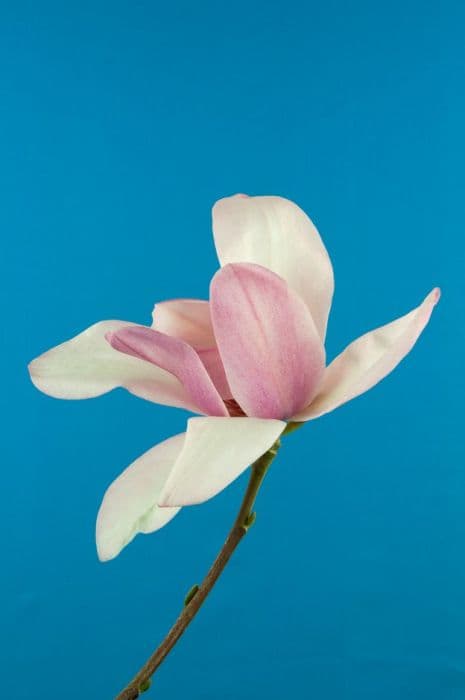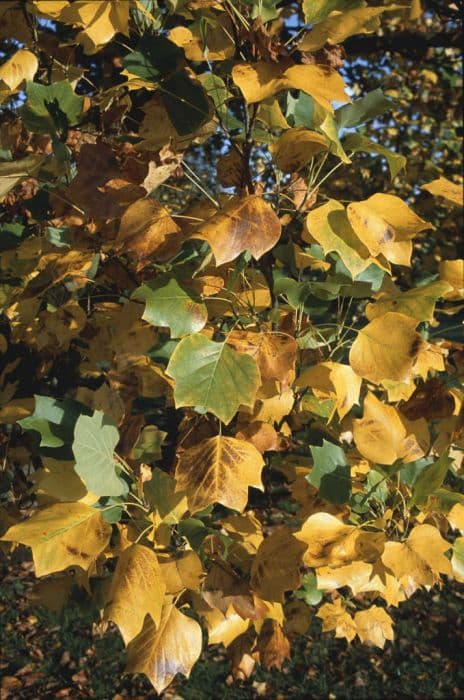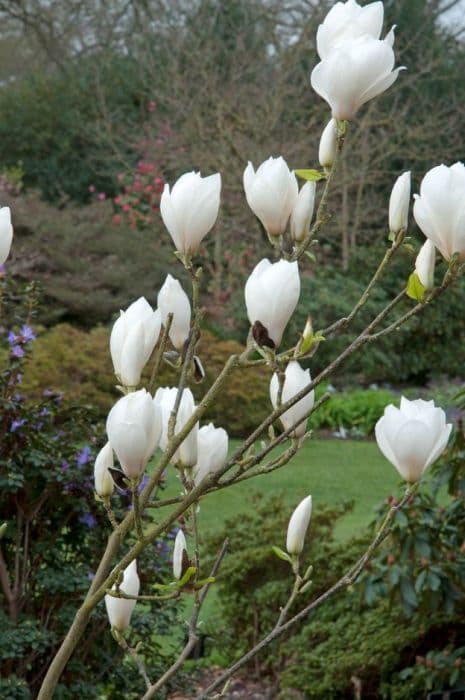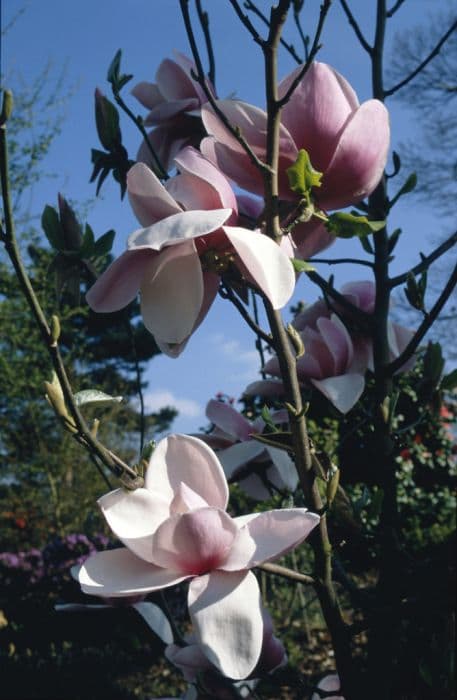Campbell's Magnolia Magnolia campbellii

ABOUT
Magnolia campbellii, commonly known as the Campbell's magnolia, is a strikingly beautiful ornamental tree celebrated for its large, showy flowers. This plant typically presents a robust, straight trunk with bark that may appear light grey and becomes slightly furrowed with maturity. The branches form a broad and spreading canopy. The leaves of Campbell's magnolia are large, glossy, and oval-shaped with a pointed tip, exhibiting a rich green color that creates a dense and vibrant foliage. As spring approaches, the tree prepares to showcase its most magnificent feature: the flowers. The blossoms of Campbell's magnolia are its crowning glory. Large and cup-shaped, these flowers can be an impressive size and are typically found in shades of pink, ranging from a soft, delicate hue to a bold, deep magenta. They are composed of several thick, waxy petals that unfurl from fuzzy buds. The blooming period yields an enchanting display that is both visually striking and fragrant, with a sweet, heady aroma that perfumes the air around it. As the flowering season progresses, the plant produces cone-like fruiting bodies that later release individual red-coated seeds, adding another layer of interest to the plant's profile. Overall, the Campbell's magnolia is a breathtaking specimen known for its spectacular floral display and attractive foliage, creating a dramatic and exotic focal point in any suitable landscape.
About this plant
 Names
NamesFamily
Magnoliaceae
Synonyms
Campbell's Magnolia, Himalayan Magnolia
Common names
Magnolia campbellii var. mollicomata, Magnolia campbellii var. walciana, Magnolia mollicomata, Magnolia sargentiana var. robusta.
 Toxicity
ToxicityTo humans
Magnolia campbellii, commonly known as Campbell's magnolia, is not typically listed as a toxic plant to humans. There is little to no information suggesting that this magnolia species is poisonous or harmful if ingested. Therefore, while it's not advisable to consume parts of ornamental plants as a general rule, there are no well-documented symptoms of poisoning or adverse consequences associated with the ingestion of Campbell's magnolia.
To pets
Campbell's magnolia, the common name for Magnolia campbellii, does not have a reputation for being toxic to pets. Like for humans, there is a general lack of evidence indicating that pets would experience poisoning from ingesting this plant. While pets should not be encouraged to eat ornamental plants, ingestion of Campbell's magnolia is unlikely to result in significant toxic effects or symptoms of poisoning.
 Characteristics
CharacteristicsLife cycle
Perennials
Foliage type
Deciduous
Color of leaves
Green
Flower color
Pink
Height
66 feet (20 meters)
Spread
33 feet (10 meters)
Plant type
Tree
Hardiness zones
7
Native area
Himalayas
Benefits
 General Benefits
General Benefits- Landscape Aesthetics: Magnolia campbellii, commonly known as Campbell's Magnolia, features magnificent blooms which enhance the visual appeal of landscapes and gardens.
- Shade and Shelter: With its broad canopy, this magnolia provides shade and shelter for smaller plants and animals.
- Habitat Provision: Its branches and leaves offer a habitat for various bird species and other wildlife.
- Pollinator Attraction: The large flowers are attractive to pollinators such as bees, promoting biodiversity within the environment.
- Seasonal Interest: This magnolia is known for its early spring blooms, which add interest and color to gardens after the winter season.
- Educational Value: Magnolia campbellii can serve as a resource for educational purposes in botanical gardens and schools, teaching about plant biology and ecology.
- Cultural Significance: The plant holds cultural importance in various parts of the world and can feature in cultural events and celebrations.
- Recreational Use: Often found in parks and public gardens, it provides a serene environment conducive to relaxation and recreation for visitors.
 Medical Properties
Medical Properties- Anti-inflammatory: Magnolia campbellii bark extract may possess anti-inflammatory properties.
- Antioxidant: The plant has been reported to have antioxidant effects due to the presence of certain bioactive compounds.
- Antibacterial: Some studies suggest that extracts from the Magnolia campbellii might exhibit antibacterial activity against various bacterial strains.
- Anxiolytic: Magnolia campbellii could potentially have anxiolytic effects, helping to reduce anxiety.
 Air-purifying Qualities
Air-purifying QualitiesThis plant is not specifically known for air purifying qualities.
 Other Uses
Other Uses- Magnolia campbellii wood is sometimes used in fine woodworking or for making furniture due to its workable nature and aesthetically pleasing grain patterns.
- The bark of the Magnolia campbellii tree can be utilized in the production of a natural dye, providing colors that range from greens to browns depending on the mordant used.
- Flowers of the Magnolia campbellii can serve as a delicate ingredient in high-end culinary arts, being crystallized or used as a garnish for extravagant dishes.
- The large, sturdy leaves are often used in floral arrangements or as natural decor, especially in East Asian artistic traditions.
- Fallen Magnolia campbellii petals are sometimes incorporated into organic mulches or composts, adding nutrients as they decompose.
- Magnolia campbellii is a sought-after specimen for arboretums and botanical gardens, where its magnificent bloom becomes a focal point for plant enthusiasts.
- In landscape architecture, Magnolia campbellii is utilized for its majestic appearance and the grandeur it lends to parklands and large gardens.
- The seed cones can be collected and used in crafts or as a natural potpourri, often for their interesting texture and aesthetic appeal.
- Horticulturists may graft Magnolia campbellii onto hardier rootstocks of different Magnolia species to propagate cultivars with desired characteristics.
- After drying, the leaves of Magnolia campbellii can be used to create eco-friendly packing materials as an alternative to synthetic foams.
Interesting Facts
 Feng Shui
Feng ShuiThe Magnolia is not used in Feng Shui practice.
 Zodiac Sign Compitability
Zodiac Sign CompitabilityThe Magnolia is not used in astrology practice.
 Plant Symbolism
Plant Symbolism- Perseverance and Endurance: Magnolia campbellii, often known as Campbell's Magnolia, has the ability to withstand harsh conditions, symbolizing strength and the ability to stand firm in the face of adversity.
- Nobility: Its impressive size and stunning flowers are associated with a noble spirit and dignity, often aligning it with those of high status or admirable qualities.
- Femininity and Beauty: The delicate and often large flowers represent beauty, grace, and the feminine aspect of nature.
- Purity and Innocence: The pure white color of some of its flowers symbolizes innocence and purity of heart.
 Water
WaterThe Campbell's magnolia needs consistent moisture but does not tolerate standing water. Young trees should be watered deeply at least once a week, providing around 15 to 20 gallons per watering, depending on soil type and weather condition. Mature trees can be watered less frequently; during dry spells, a thorough soaking every two to three weeks may suffice, ensuring the water penetrates deeply into the root zone. During the winter, watering should be reduced to prevent cold damage to the roots. It is important not to overwater, as this could lead to root rot.
 Light
LightThe Campbell's magnolia thrives best in full sun to partial shade. Ideally, planting it in a spot where it can receive at least four hours of direct sunlight followed by lightly dappled shade would be most beneficial for the plant's growth and flowering. Avoid deep shade locations, as this can impede the magnolia's health and flowering capability.
 Temperature
TemperatureCampbell's magnolia prefers a temperate climate with temperatures typically ranging from 20°F to 85°F. It is hardy in USDA zones 7 to 9, which means it can survive minimum winter temperatures of 0°F. The ideal temperature range for this magnolia is between the upper 60s and mid-70s Fahrenheit during its growing season; however, it is adaptable to slightly warmer conditions as long as the root zone remains cool and moist.
 Pruning
PruningCampbell's magnolia requires minimal pruning, primarily to remove any dead or diseased wood and to shape the tree as desired. The best time for pruning is late winter or early spring before new growth starts. Pruning should be done sparingly, as the plant heals slowly from cuts; remove only what is necessary to maintain the health and appearance of the tree. Pruning annually or biennially is typically sufficient.
 Cleaning
CleaningAs needed
 Soil
SoilCampbell's Magnolia prefers slightly acidic to neutral soil with a pH of 5.5 to 7.0. The best soil mix should be rich, well-draining, and loamy, with a good amount of organic matter like compost or leaf mold to retain moisture and provide nutrients.
 Repotting
RepottingCampbell's Magnolia generally does not need to be repotted often as it is typically grown as an outdoor tree. However, if grown in a container, it should be repotted every 2 to 3 years to prevent root-bound conditions and to replenish the soil.
 Humidity & Misting
Humidity & MistingCampbell's Magnolia thrives best in moderate to high humidity levels, typical of its natural forested habitat. Maintaining ambient humidity around 50-60% is ideal for its growth.
 Suitable locations
Suitable locationsIndoor
Provide bright light, keep soil moist, and ensure high humidity.
Outdoor
Plant in well-drained soil, sunny to partial shade area.
Hardiness zone
7-9 USDA
 Life cycle
Life cycleThe life cycle of Magnolia campbellii, commonly known as Campbell's magnolia, begins with seed germination, which requires a period of cold stratification to break dormancy. Once germinated, the seedling grows into a young plant, establishing roots and producing its first set of leaves. As it matures into an adult, it develops a woody trunk and branches, forming the characteristic large, broadly conical to rounded crown. After reaching maturity, which can take several years, Magnolia campbellii produces large, showy flowers, typically in pink or white, signaling its readiness for reproduction. Following pollination, usually by beetles, it develops into fruiting bodies that release seeds, completing the cycle as these seeds disperse, potentially giving rise to new plants. Throughout its lifetime, which may span many decades, the tree undergoes periodic growth and regenerative phases, with seasonal leaf drop and regrowth in temperate climates.
 Propogation
PropogationPropogation time
Spring to Summer
Propogation: The most popular method of propagating the Himalayan magnolia, or Magnolia campbellii, is by grafting, particularly during the late winter or early spring when the plant is not in active growth. In this process, a piece of stem from a mature magnolia with desirable characteristics is attached to the rootstock of another plant. The grafted union must be kept under high humidity and ideally at a temperature around 55-70 degrees Fahrenheit (around 12-21 degrees Celsius) to encourage successful healing and union. The grafted plants are usually kept in a mist bed with bottom heat to maintain optimal conditions. It can take several weeks to months for the graft to heal and start growing as a new plant. This method is preferred as it helps to maintain the specific qualities of the parent plant.









